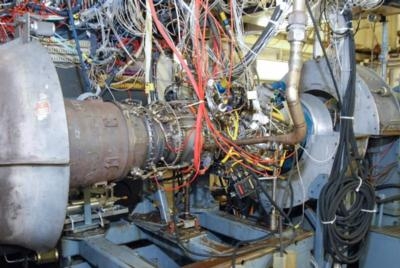Supporting The U.S. Army's Improved Turbine Engine Program
GE Aviation successfully completed testing a T901-GE-900 turboshaft engine prototype in support of the United States Army's Improved Turbine Engine Program (ITEP). The company-funded test engine exceeded ITEP performance requirements, proving that the GE T901 engine is ready for the ITEP Engineering and Manufacturing Development (EMD) phase. The T901 engine tests were conducted over the span of six months and verified growth margin to meet future ITEP power requirements.

Following the completion of the T901 prototype test, GE continued the company-funded portion of its development program by running compressor, combustor and turbine component tests at its facilities in Lynn, Mass., and Cincinnati, Ohio. In addition, GE is utilizing the advanced turbine testing capability at the University of Notre Dame's Turbomachinery Laboratory (NDTL) in South Bend, Ind., where GE committed $13.5 million to fund advanced research and testing in 2014.
Since 2010, GE invested more than $9 billion in maturing commercial technologies applicable to the T901. During that same timeframe, GE spent more than $300 million to develop and test T901-specific technologies ahead of an upcoming preliminary design review (PDR) scheduled with the United States Army Contracting Command (ACC), based at Redstone Arsenal in Huntsville, Ala. These company-funded investments demonstrate GE's commitment to Better Buying Power 3.0's Industry Productivity and Innovation recommendations resulting in technology maturation benefits to the U.S. Department of Defense.
In 2016, the Army awarded GE Aviation a $102-million, 24-month contract culminating in the T901 PDR, after which the Army plans to select a single supplier to complete the Engineering and Manufacturing Development (EMD) phase of ITEP. Since the start of the ITEP PDR contract, GE assembled a top technical team of more than 100 experienced engineers from commercial and other programs to focus on the T901 PDR efforts.
"To validate our analytical models ahead of the ITEP PDR with the Army, it was critical to demonstrate that a T901 prototype engine outfitted with the latest and greatest commercial and military technologies will meet ITEP performance requirements-there is no substitute for testing," said Ron Hutter, executive director of the T901 program. "Beyond the advanced design and hardware, the T901 features the latest diagnostic and prognostic tools with a modular architecture that provides the Army with the flexibility to improve readiness at the lowest life cycle costs. The T700's modular engine architecture proved in austere operating conditions to be highly maintainable in a fix-forward, expeditionary environment while minimizing the logistics footprint and overall sustainment costs."
The T901 incorporates extensive use of advanced manufacturing and high-temperature material technologies initially developed and matured for GE's commercial jet engines, such as ceramic matrix composites (CMCs) and additive manufactured components pioneered on the best-selling LEAP and GE9X engines. These innovations-which dramatically reduce fuel consumption and lower aircraft operating weight-will have millions of hours of operating experience by the time the T901 enters production, enabling the engine to meet or exceed the Army's aggressive performance targets with field-proven, low-cost technologies.
The T901 will utilize a significant number of additive parts, leveraging investments in new production plants, equipment and designs utilized for GE's commercially-funded programs such as the Advanced Turboprop (ATP) for the Cessna Denali. Additive manufacturing allows GE to build complex parts with advanced, 3D shapes at lower weight and with better performance and durability. For example, the T901 includes an additive part that reduces an assembly of more than 50 subcomponents into one part. To learn how GE utilizes additive manufacturing to build parts, watch this YouTube video by clicking here.
"With traditional machining and fabrication methods, individual parts are machined into finished parts from castings or forgings and built into assemblies using welding/brazing or bolted joints," said Hutter. "On the T901, additive manufacturing reduces weight by minimizing attaching features in assemblies. Additive also allows for more advanced aerodynamic shapes, leading to better engine performance, reliability and durability for the Army."
GE also leads the jet propulsion industry in CMC technologies. The T901 will incorporate CMC components to improve performance and reduce weight. More durable and capable of withstanding higher temperatures than metal alloys, CMCs allow less cooling air to be used to cool parts in the engine's hot section, thus improving engine efficiency. The millions of hours of CMC parts experience from LEAP commercial engines will be leveraged to incorporate similar components into the T901.
(Image provided with GE Aviation news release)
 ANN's Daily Aero-Linx (04.17.24)
ANN's Daily Aero-Linx (04.17.24) ANN's Daily Aero-Term (04.17.24): Jamming
ANN's Daily Aero-Term (04.17.24): Jamming ANN's Daily Aero-Linx (04.18.24)
ANN's Daily Aero-Linx (04.18.24) Aero-News: Quote of the Day (04.18.24)
Aero-News: Quote of the Day (04.18.24) ANN's Daily Aero-Term (04.18.24): Hold-In-Lieu Of Procedure Turn
ANN's Daily Aero-Term (04.18.24): Hold-In-Lieu Of Procedure Turn



